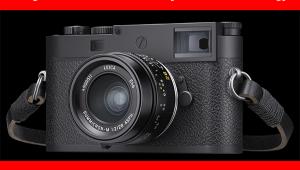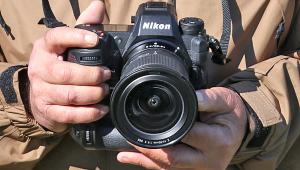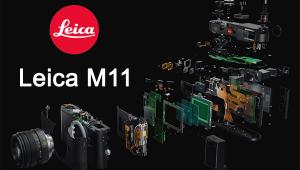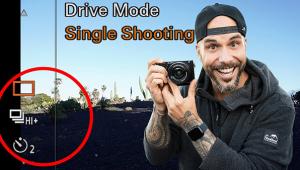Fujifilm X-T1 Mirrorless Camera Review

[Editor's Note: Lab test and comments are by Betternet, Shutterbug’s TIPA-affiliated testing lab. TIPA (www.tipa.com) is a worldwide association of photo and imaging magazine editors. Shutterbug is the sole US member of the association, and Editor at Large George Schaub serves as a member of the Technical Committee. Please click on the Image Tech tab on the home page for more camera review tests.]
The Fujifilm X-T1 is a retro-style mirrorless Compact System Camera (CSC) that looks like an SLR of the 1970s and offers numerous setup dials to change nearly all image parameters without using the LCD screen menu. A dial for shutter speed, ISO speed, and EV control (+/- 3 EV steps) sits atop the camera. Below the ISO speed and the shutter speed dial, the camera offers additional setup rings that allow for change of the exposure mode (spot metering, for example), of the drive mode (single shot, continuous shot in two different rates), or to activate the bracketing function.
All this gives the photographer the ability to change modes in a very comfortable way. By turning the shutter speed dial to a desired setting (instead of the default Auto setting) the user can choose shutter priority mode. Using the lens ring to change the aperture will activate the aperture priority mode, and using both dials and rings allows the user to shoot in manual.




The camera looks like an SLR but is a CSC with an electronic viewfinder. This viewfinder is the best electronic viewfinder we’ve seen so far. Unlike electronic viewfinders of some other CSC systems, it has an extremely high resolution of 2.36 million RGB dots, and compared to other cameras it is extremely large and offers a viewfinder factor of 0.77 (which is very high for a camera with an LCD viewfinder and APS-C-sized sensor). Working with this electronic viewfinder is very comfortable. It offers an electronic magnifier function, focus peaking, and more to facilitate manual focusing.
The camera has a Wi-Fi module and new Wi-Fi software, which is much more comfortable than former software for X-series cameras. While the W-LAN function of cameras like the Fujifilm X-E2 can only be used for wireless image data transfer, the new software for the X-T1 allows for use of a smartphone as a wireless remote control.
Comments On Image Quality
Color: The color results of the Fujifilm X-T1 are excellent. The white balance system worked very well. The gray patterns in our test chart are located in the center and show only a minor shift into cooler/bluish color areas, while the white pattern shows a shift into the yellow area. The skin tone reproduction is nearly perfect. Skin tones are a little bit “optimized” by higher orange rates. This is visible in our test chart and our portrait shot.

The saturation of the images is a little high. The photographer can change that by using different “film simulations” in the menu setting which will change the contrast and color reproduction. By shooting Raw the camera is capable of delivering perfect color reproduction.
Sharpness: The resolution results are excellent. The Fujifilm X-T1 reproduced the ISO 12.233 chart with 3183 lines per picture height, which is nearly its nominal sensor resolution of 3264 lines per picture height. Fine details like the metal structure of the sieve in our standard test box shot or the hair in our portrait shot are reproduced very clearly and without visible sharpness filtering effects. And these are results from use of the kit lens. The camera and lens combination creates images without any chromatic aberration in the image center and only minor aberration effects in the corners of the image.

Noise: The Fujifilm X-T1 showed very good performance in our noise test. The luminance noise level is extremely low. Even at the highest ISO speed settings there are nearly no noticeable color noise artifacts. The camera uses an intelligent and very unobtrusive filtering system that doesn’t reduce image detail like many other digital cameras do in the highest ISO speed settings. Only at the highest ISO speed setting of 6400 did we notice some artifacts that make the anti-noise filtering visible.
The dynamic range results are very good. The camera gained a maximum of 11.4 f/stops and keeps a high level of more than 10 f/stops up to ISO 3200.
Comments On Video Functions
The Fujifilm X-T1 records Full HD videos with 1920x1080 pixels and with up to 60 progressive frames per second. It offers an additional 30p mode. The video files are saved as Apple QuickTime Movies and use H.264 compression technology. Just like in videos taken with other Fujifilm X-series cameras, the data rate of these files is higher than the movie files created by other digital cameras. The test clip we shot has a data rate of 38 Mbit/s max. The camera is able to use the most modern SD card systems like SDXC (UHS-II) for its very fast image recording and for video recording with these high bit rates.
The camera offers manual settings in video modes. Just like in photo mode, the aperture size can be assigned by using the lens ring and the same applies to the ISO speed setting, which is controlled by the large ISO dial on top of the camera.
The camera doesn’t offer an analog TV PAL/NTSC interface; instead, it uses an HDMI interface for image and video presentation on high-definition screens. Image and video files are transferred by a USB 2.0 interface.
In addition, it has a 3.5mm jack for an external microphone. The user can change the sound level manually. Combined with the manual exposure settings, the photographer can set up the video modes of the X-T1 exactly to fit his or her needs.

Comments On Video Quality
Like nearly all Fujifilm X-series cameras, the X-T1 produces poor video quality. The camera showed extreme moiré effects in our standard ISO 12.233 test chart. Test patterns built up of fine lines are converted into dazzling rainbows. The center pattern with fine circles also shows these effects.
The moiré effects in the real-life sample clip aren’t as intense as the effects in our test chart. The low resolution of the video may be the reason for this. The X-T1 gained a maximum of 457 lines per picture height (of nominal 1080 lines per picture height in Full HD resolution). This is only a little better than the result of the Fujifilm X-E2, for example.
The sample shots we made show a very abrupt change of exposure settings in auto mode. While many other CSC cameras will change the exposure settings smoothly, the changes done by the X-T1 are clearly visible.
The color results in video modes are very good. The X-T1 showed very realistic colors. Just as in photo mode, the automatic white balance system worked very well, the gray test pattern is located right in the center of the result chart. Only the brightest gray (or nearly white) shows a shift into the yellow and green direction. Skin tones are reproduced naturally, but with a little higher magenta rate.

Lab results and test images by BetterNet, our TIPA-affiliated testing lab.
Scorecard
Pro
+ Portable CSC system with APS-C-sized sensor
+ High-quality images due to X-TransCMOS II sensor
+ Extremely large viewfinder with veryhigh resolution
+ Classic camera handling and robustbody that is sealed and waterproof
+ Wi-Fi function including remote control
Con
- Small grip on the right-hand side of the body (not that comfortable for photographers with large hands)
- Poor video quality
Image Tech is where we publish web-exclusive lab reports on cameras. To read the reports please go to the Shutterbug homepage at www.shutterbug.com and click on the Image Tech tab on the top navigation bar. New reports are published frequently, so check Image Tech for updates.
The Fujifilm X-T1 (body only) has a list price of $1299.95; $1699.95 with the addition of an 18-55mm f/2.8-4 R LM OIS kit lens. For more information, visit www.fujifilmusa.com.
- Log in or register to post comments

















































